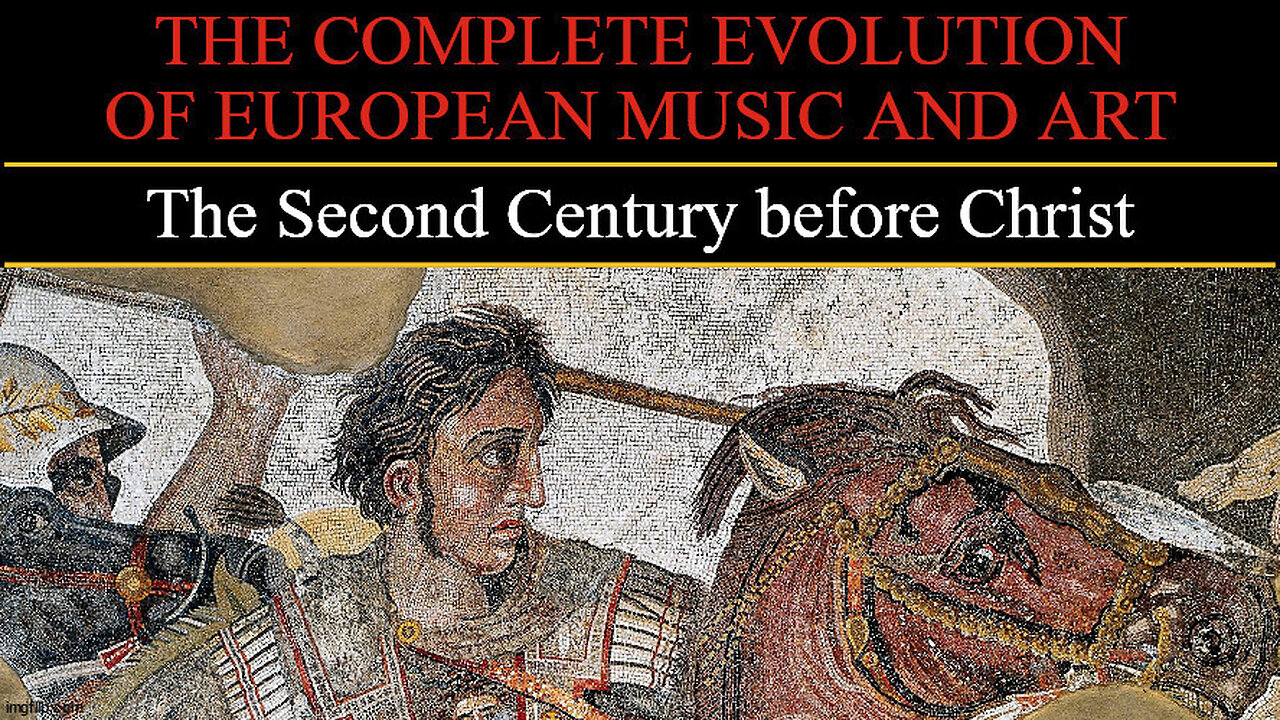Premium Only Content

Timeline of European Art and Music - The Second Century BC
Music timestamps (only two this time, spread out in replies)
0:00 - 133 BC - Athenios son of Athenios (Greek) - The First Delphic Hymn To Apollo
In the first verse verse the singers call on the Muses (goddesses of music and dance) to leave their home on Mount Helicon and to join in the song in honour of Apollo. This part has been translated by Armand D'Angour as follows:
"Hark, you whose domain is deep-forested Helicon, loud-thundering Zeus’ fair-armed daughters: come with songs to celebrate your brother Phoebus of the golden hair, who over the twin peaks of this mountain, Parnassus, accompanied by the far-famed Delphic maidens, comes to the streams of the flowing Castalian spring as he visits his mountain oracle."
The second verse describes the presence of the delegation from Attica and the sacrifice of Arabian incense and young bulls that they are making. It also mentions the sound of the pipes (auloi) and the lyre (cithara) accompanying the sacrifice.
"Behold, Attica with its great city (Athens) is at prayer, dwellers on the unconquered land of the armed Tritonian goddess (Athena); and on the holy altars Hephaistos (i.e. fire) consumes the thighs of bull-calves; and together with the smoke, Arabian incense rises to the heavens. And the shrill, blaring aulos weaves a melody with fluttering notes, and the golden, sweet-voiced kithara blends with the song of praise."
The third verse is rather fragmentary, with several gaps in the words and music, but enough survives to make sense of it. In this verse the singers address Apollo directly, and describe how he took over the prophetic tripod at Delphi after killing the snake that guarded it, and how once he thwarted an army of invading Gauls
5:00 - 128 BC - Limenios son of Thoinos (Greek) - Second Delphic Hymn to Apollo
The first verse -
"Come ye to this twin-peaked slope of Parnassos with distant views, [where dancers are welcome], and [lead me in my songs], Pierian Goddesses who dwell on the snow-swept crags of Helikon. Sing in honour of Pythian Phoebus, golden-haired, skilled archer and musician, whom blessed Leto bore beside the celebrated marsh, grasping with her hands a sturdy branch of the grey-green olive tree in her time of travail."
The hymn goes on to describe how the sky and sea rejoiced at Apollo's birth on the island of Delos, and how Apollo, after his birth, visited Attica; ever since which time the people of Attica have addressed Apollo as "Paian"
The final part of the work is the prosodion, or processional hymn, with the metre changing from cretic. In this part, the singers beg Apollo and his sister Artemis ("mistress of Cretan bows") to protect Athens as well as Delphi, and they close with a prayer for the continued dominion of the victorious Roman empire.
Both Delphic Hymns were addressed to Apollo, and were found inscribed on stone fragments from the south outer wall of the Athenian Treasury at Delphi (Greece).
-
 2:16:53
2:16:53
FreshandFit
5 hours agoCall-In Show
45.6K10 -
 4:27:46
4:27:46
Nerdrotic
9 hours ago $38.54 earnedDaredevil Born Again REVIEW, Harry Potter Show DOA, DC HACKED! | Friday Night Tights 344 Paul Chato
118K38 -
 1:15:15
1:15:15
Glenn Greenwald
6 hours agoWeek in Review: Lee Fang and Leighton Woodhouse on Ukraine War and NYT Piece Revealing Tensions within Trump Admin; PLUS: Lee Fang Takes Audience Questions on DOGE and Big Tech | SYSTEM UPDATE #420
61.4K42 -
 1:03:30
1:03:30
Sarah Westall
8 hours agoMassive Government Overhaul: FBI, CIA, IRS and more to be Gutted w/ Sam Anthony
73.7K19 -
 1:07:40
1:07:40
IsaacButterfield
8 hours ago $2.82 earnedAustralia Under Attack | Trump's State of the Union | All LGBTQ Cast (W Guest Frenchy)
33.9K9 -
 1:23:37
1:23:37
Edge of Wonder
8 hours agoIs Your Car Collecting Your Biodata? Whistleblower Exposes Dark Agenda
33.7K8 -
 2:08:50
2:08:50
Quite Frankly
10 hours ago"A Rat at HHS, Gene Hackman, Musical Extras" ft. J Gulinello 3/7/25
37.7K8 -
 55:49
55:49
LFA TV
1 day agoGermany Started Two World Wars and Now Wants Nuclear Weapons | TRUMPET DAILY 3.7.25 7PM
33.9K26 -
 1:34:38
1:34:38
2 MIKES LIVE
6 hours ago2 MIKES LIVE #189 Open Mike Friday (Sort Of)
25.5K -
 1:48:14
1:48:14
Right Side Broadcasting Network
14 hours agoLIVE REPLAY: President Trump Delivers Remarks at The White House Digital Assets Summit - 3/7/25
147K42